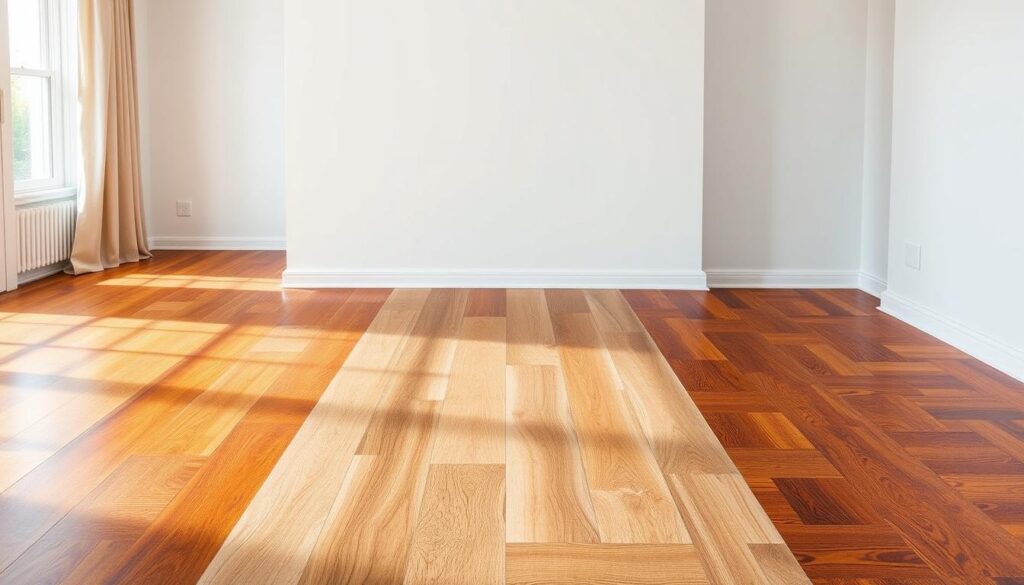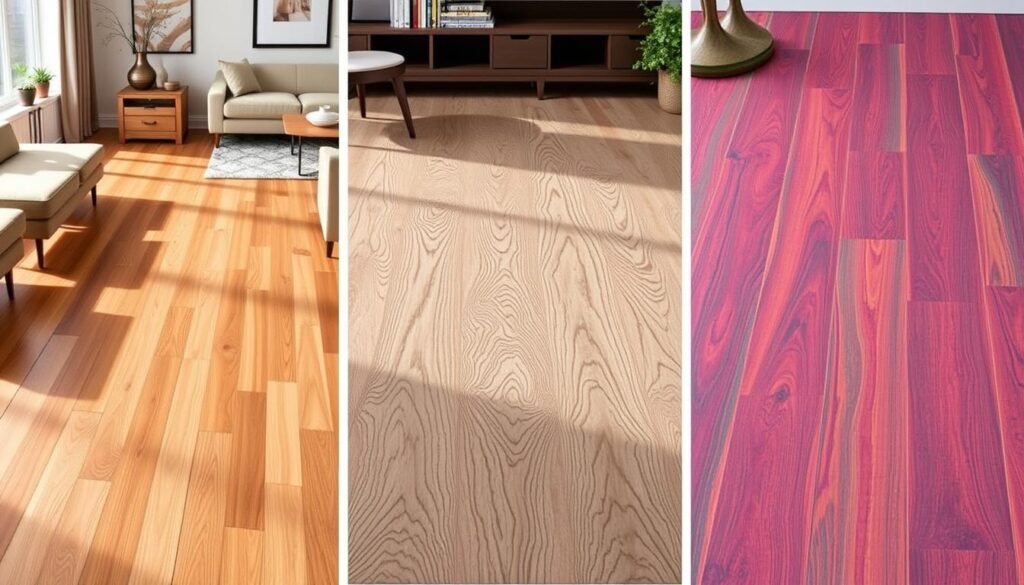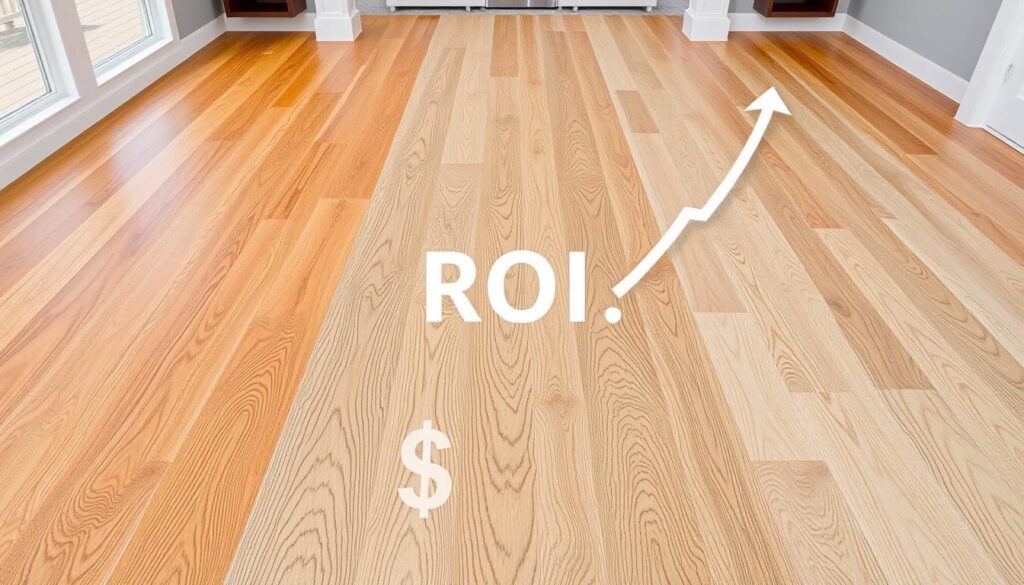Compare hardwood vs engineered vs laminate flooring to find the best option for your home. Explore costs, durability, and maintenance to make an informed flooring decision
Choosing the right flooring for your home can be tough. You have many options, each with its own benefits and drawbacks. From the classic look of hardwood to the flexibility of engineered and laminate, it’s hard to know what to pick. This guide will help you understand the differences between hardwood, engineered, and laminate flooring. We’ll make it easier for you to choose the best option for your home.

Key Takeaways
- Hardwood, engineered, and laminate flooring each have distinct advantages and drawbacks that must be considered.
- Understanding the characteristics of natural wood and synthetic materials is crucial in selecting the right flooring option.
- Cost, durability, installation, and maintenance requirements vary significantly among the three flooring types.
- Aesthetic appeal and design flexibility play a significant role in the decision-making process.
- Environmental impact and sustainability concerns are important factors to weigh when choosing your new flooring.
Understanding Different Types of Flooring Materials
There are many flooring materials to choose from. Each has its own special qualities. Knowing about wood and synthetic options helps you pick the best for your space.
Natural Wood Properties and Characteristics
Hardwood floors, like oak and maple, are loved for their beauty and strength. They bring a classic look and can last a long time with the right care. The unique grain and colors of natural wood make any room special.
Synthetic Materials in Modern Flooring
Synthetic flooring, like laminate, is popular for its flexibility and affordability. It looks like wood or stone but is made from different materials. Engineered wood combines real wood with a stable core, making it good for wet areas.
Core Material Compositions
- Hardwood flooring: Solid wood planks
- Engineered wood flooring: A top layer of real wood with a layered core, often made from plywood or high-density fiberboard (HDF)
- Laminate flooring: A composite of materials, including resin, wood fibers, and a protective wear layer
Knowing about flooring materials helps you choose what’s right for you. Whether you want natural beauty, durability, or something affordable, there’s an option.
For more info or to set up a meeting, call Timber Tropics at +6282332572828 or email info@timbertropics.com.
Cost Comparison Between Flooring Options
When looking at flooring prices, you have many choices. Each option has its own cost considerations. From affordable flooring to high-end flooring options, knowing the costs is key to a good decision.
Hardwood flooring is the priciest, costing $8 to $15 per square foot for the material. Installation adds $3 to $8 per square foot. Engineered wood floors are cheaper, costing $4 to $9 per square foot for the material and $2 to $5 for installation.
Laminate flooring is the cheapest, with material costs from $1 to $5 per square foot. Installation costs $1 to $3 per square foot. But, high-end flooring options like luxury vinyl plank (LVP) or tile may cost more upfront. They offer better durability and value over time.
| Flooring Type | Material Cost (per sq ft) | Installation Cost (per sq ft) | Total Cost (per sq ft) |
|---|---|---|---|
| Hardwood | $8 – $15 | $3 – $8 | $11 – $23 |
| Engineered Wood | $4 – $9 | $2 – $5 | $6 – $14 |
| Laminate | $1 – $5 | $1 – $3 | $2 – $8 |
Understanding flooring prices helps you choose wisely. Whether you want the cheapest option or are looking to splurge, this guide helps you make a confident choice.
Video source from Youtube
Durability and Lifespan Analysis
Choosing the right flooring for your home is important. Durability and long-term performance are key. Hardwood, engineered, and laminate floors each have their own strengths.
Impact Resistance Features
Hardwood floors are strong and can handle a lot of foot traffic. Engineered flooring is also durable, thanks to its layered design. Laminate floors have a special wear layer to protect against scratches and dents.
Wear Layer Protection
- Hardwood floors need regular care to keep looking good. They can be refinished to maintain their beauty.
- Engineered floors have a real wood top layer. This can be sanded and refinished many times, making them last longer.
- Laminate floors have a tough wear layer. This keeps the surface looking new, even with heavy use.
Long-term Performance Expectations
Hardwood floors can last for decades with the right care. Engineered floors also offer long-lasting durability. Laminate floors are easy to maintain but don’t last as long.
Think about your lifestyle and budget when choosing flooring. The right choice will make your home beautiful for years to come.
Installation Methods and Complexity
Choosing the right flooring is just the start. The installation process affects the cost and complexity of your project. Knowing the process helps you decide between DIY or professional services.
DIY Flooring Installation: A Cost-Effective Approach
DIY installation is great for handy homeowners, especially with laminate or LVP. These floors are easy to install because of their snap-together systems. But, it takes time and effort. DIY saves on labor costs but might be harder and riskier.
Professional Flooring Installation: Ensuring a Flawless Finish
For a hassle-free installation, especially with hardwood or engineered wood, get a pro. Professionals have the tools and know-how for a perfect job. While it costs more, it’s worth it for a quality finish and avoiding mistakes.
| Flooring Type | DIY Installation | Professional Installation |
|---|---|---|
| Laminate | Moderate complexity | Recommended for best results |
| Luxury Vinyl Plank (LVP) | Relatively easy | Recommended for best results |
| Engineered Wood | Moderate to high complexity | Highly recommended |
| Solid Hardwood | High complexity | Highly recommended |
Choosing between DIY and professional installation depends on your skills, project complexity, and budget. Think about the pros and cons for a successful flooring installation. For more info or to book a pro, call Timber Tropics at +6282332572828 or email info@timbertropics.com.
Hardwood vs Engineered vs Laminate Flooring: A Complete Breakdown
Choosing the right flooring for your home can be tough. There are many options, from classic hardwood to modern engineered and laminate floors. Each type has its own benefits, fitting different needs and tastes. We’ll look at how these floors perform, their moisture resistance, and upkeep needs. This will help you pick the best flooring for your home.
Performance in Different Climates
Hardwood floors are loved for their beauty but can be affected by the climate. In humid or changing temperature areas, they might warp or crack. Engineered wood is more durable, thanks to its layered design that fights moisture and temperature changes. Laminate flooring is the most suitable for changing weather, thanks to its water-resistant core.
Moisture Resistance Comparison
For those looking for floors that resist moisture, engineered wood and laminate are top choices. Engineered wood has a protective layer against water damage. Laminate’s synthetic core is naturally water-resistant. Hardwood, being natural, is more prone to moisture damage, making it less ideal for wet areas.
Maintenance Requirements
Laminate and engineered wood are easy to maintain, making them great for busy homes. Laminate floors just need a quick sweep and occasional damp mop to stay clean. Engineered wood is a bit more work than laminate but still easier than solid hardwood. Solid hardwood needs regular refinishing and sealing to stay looking good.
| Flooring Type | Climate Performance | Moisture Resistance | Maintenance Requirements |
|---|---|---|---|
| Hardwood | Susceptible to warping, cupping, and cracking in variable climates | Least moisture-resistant | Requires regular refinishing and sealing |
| Engineered Wood | More resilient to climate changes | Moderately moisture-resistant | Simpler maintenance routine compared to hardwood |
| Laminate | Highly climate-appropriate | Highly moisture-resistant | Minimal maintenance required |
Knowing the strengths and weaknesses of hardwood, engineered, and laminate floors helps you choose wisely. Whether you need flooring that’s good for your climate, resists moisture, or is easy to care for, this guide can help. It’s all about finding the perfect fit for your home.
Aesthetic Value and Design Options
Flooring is not just about function; it’s also about looks. Hardwood, engineered, and laminate floors come in many flooring styles, wood floor patterns, and flooring color options. Whether you love traditional hardwood or modern engineered planks, the right choice can change your space’s look and feel.
Hardwood floors have different species, each with its own grain and color palettes. Oak offers warm tones, while maple is sleek and modern. Engineered floors also have many wood floor patterns, like herringbone and chevron, to match any décor.
Laminate flooring has improved a lot. It looks like natural wood but costs less. With many flooring color options and textures, laminate floors fit any room. They work well in farmhouse kitchens and modern living spaces.
“The right flooring can be the foundation that ties an entire room together, elevating the overall aesthetic and creating a cohesive, visually striking space.”
Whether you prefer hardwood, engineered, or laminate, there are endless choices. With creativity and careful thought, you can make your home a beautiful reflection of your style.

Environmental Impact and Sustainability
Being eco-conscious means thinking about the environment when we choose home improvements. This includes the flooring we pick. Knowing how eco-friendly flooring is made and if it can be recycled helps us make better choices.
Manufacturing Process Analysis
Sustainable wood floors are made with care for the environment. They use renewable and fair sources. Engineered and laminate floors use recycled materials, making them better for the planet.
- Hardwood flooring: Uses sustainable wood and cuts down waste.
- Engineered wood floors: Has a wood top and a core of recycled wood, making it eco-friendly.
- Laminate flooring: Made from recycled wood and synthetic materials, it’s recyclable.
Recycling Possibilities
At the end of their life, flooring’s sustainability matters a lot. Hardwood floors can be refinished and reused. Engineered and laminate floors can be recycled or repurposed.
“Choosing eco-friendly flooring not only benefits the environment but can also add long-term value to your home.”
Thinking about the environment and sustainability helps us choose better flooring. This choice reflects our values and helps the planet. For more info, contact Timber Tropics at +6282332572828 or info@timbertropics.com.
Resale Value and Return on Investment
Choosing the right flooring can greatly affect your home’s resale value. Hardwood, engineered, and laminate floors each have their own benefits. These can impact the home value increase and flooring ROI you see.
Hardwood floors are seen as the top choice for their beauty and lasting quality. Homes with hardwood floors usually sell for more. Engineered wood and laminate floors also offer good returns, but they’re cheaper and easier to put in.
| Flooring Type | Resale Value Impact | Estimated ROI |
|---|---|---|
| Hardwood | Highest increase in home value | 80-100% |
| Engineered Wood | Moderate increase in home value | 60-80% |
| Laminate | Lowest increase in home value | 40-60% |
When picking flooring, think about the long-term money benefits and how it will affect your home’s resale. The right flooring can boost your flooring ROI and home value increase when you sell.

“Investing in high-quality flooring can be a smart decision that pays off when it’s time to sell your home.”
Room-Specific Recommendations
Choosing the right flooring for your home is all about the needs of each room. Whether it’s your kitchen, bathroom, or living areas, the right flooring makes a big difference. It affects how your space looks, feels, and lasts over time.
Kitchen and Bathroom Considerations
In the kitchen and bathroom, water-resistant flooring is key. Kitchen flooring needs to handle spills and lots of foot traffic. Vinyl, tile, or waterproof laminate are great options. For the bathroom, where moisture is even higher, go for porcelain tile, luxury vinyl plank (LVP), or engineered wood.
Living Areas and Bedrooms
In the best flooring for living rooms and bedrooms, comfort and looks are important. Hardwood, luxury vinyl, and quality laminate offer a cozy feel and last long. Think about foot traffic, furniture, and your style to pick the best flooring for these rooms.
| Room | Recommended Flooring | Key Considerations |
|---|---|---|
| Kitchen | Vinyl, Tile, Waterproof Laminate | Water resistance, durability, easy maintenance |
| Bathroom | Porcelain Tile, LVP, Engineered Wood | Moisture protection, slip resistance, waterproof surface |
| Living Room | Hardwood, Luxury Vinyl, Laminate | Comfort, aesthetics, long-term performance |
| Bedroom | Hardwood, Luxury Vinyl, Laminate | Comfort, warmth, low-maintenance |
Think about each room’s special needs to pick the best flooring. It should look good and work well. For help choosing the right flooring, call us at +6282332572828 or info@timbertropics.com.
Maintenance Tips and Care Instructions
Keeping your floors beautiful and lasting requires some care. Whether they’re hardwood, engineered, or laminate, follow these floor cleaning tips, wood floor maintenance, and laminate floor care tips. This way, your floors will stay in great shape for many years.
Hardwood Floor Maintenance
For hardwood floors, it’s important to sweep or vacuum often. This removes dirt and debris. Don’t use water or harsh cleaners, as they can harm the wood. Instead, use a hardwood floor cleaner or a mix of warm water and mild soap.
Place area rugs in busy areas and use furniture pads to prevent scratches. This helps protect your floors.
Engineered and Laminate Floor Care
Engineered and laminate floors are more durable than solid hardwood. But, they still need proper care. Sweep or vacuum these floors often. Use a damp mop or a cleaner made for engineered or laminate floors.
Don’t let water sit on the surface. It can cause swelling or discoloration.
| Flooring Type | Cleaning Recommendations | Protective Measures |
|---|---|---|
| Hardwood | Sweep/vacuum, use specialized cleaner | Area rugs, furniture pads |
| Engineered | Sweep/vacuum, use engineered floor cleaner | Avoid standing water |
| Laminate | Sweep/vacuum, use laminate floor cleaner | Avoid standing water |
Remember, regular and proper care is key to beautiful floors. For any questions or concerns, contact us at +6282332572828 or info@timbertropics.com.
Conclusion
This guide has shown you the differences between hardwood, engineered, and laminate flooring. You’ve learned about cost, durability, and how easy they are to install. Each type has its own benefits, fitting different tastes and needs.
Choosing the right flooring depends on your budget, lifestyle, and what you want your space to look like. Whether you prefer the classic look of hardwood, the flexibility of engineered floors, or the cost-effectiveness of laminate, pick what suits you best.
Still not sure about your flooring choice? Timber Tropics experts are here to help. We offer personalized advice and can answer any questions. Contact us at +6282332572828 or info@timbertropics.com to get the right flooring for your home.
FAQ
What are the key factors to consider when choosing between hardwood, engineered, and laminate flooring?
When picking flooring, think about cost, durability, looks, and upkeep. Each type has its own traits. These can affect your choice based on your needs and budget.
How do the initial purchase prices and installation costs differ between the flooring options?
Hardwood floors cost the most upfront and to install. Laminate is the cheapest. Engineered wood is in the middle, offering quality at a lower price.
Which flooring type is the most durable and long-lasting?
Hardwood floors last a long time with the right care. Engineered and laminate floors also resist wear well. But, hardwood is the longest-lasting.
How complex is the installation process for each flooring type?
Laminate floors are easy to put in, even for DIY fans. Engineered wood is a bit harder. Hardwood floors need a pro for the best look.
What are the differences in moisture resistance between the flooring options?
Laminate and engineered wood handle moisture better than hardwood. This makes them good for wet places like kitchens and bathrooms. Hardwood needs careful care to avoid damage.
How do the aesthetic options and design versatility compare?
Hardwood floors have a natural look with many choices. Engineered and laminate floors can look like hardwood but are more flexible and affordable.
Which flooring type is the most environmentally friendly and sustainable?
Hardwood from well-managed forests is the greenest choice. Engineered and laminate can be eco-friendly too. But, making them might harm the environment more.
How do the different flooring types impact a home’s resale value?
Hardwood floors boost a home’s value the most. Engineered wood also adds value. Laminate floors might not affect value as much.
What are the best room-specific recommendations for each flooring type?
Use hardwood and engineered wood in living areas and bedrooms. For kitchens and bathrooms, laminate or engineered wood is better. Choose based on each room’s needs.
How can I properly maintain and care for my chosen flooring type?
Keeping your floors in top shape is crucial. Clean them regularly and protect them from damage. Fix any problems fast. Always follow the manufacturer’s care tips.
Related article : Buy Quality Imitation Timber Flooring | Best Prices USA
